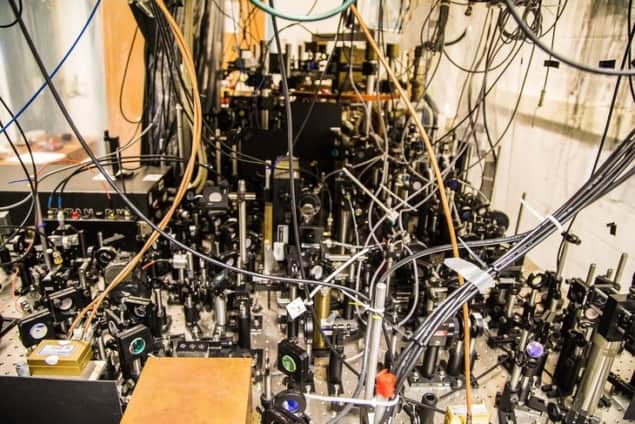
Physicists in the US have shown that normally gregarious bosons can behave like solitary fermions and occupy distinct quantum states when cooled down to very low temperatures and manipulated with laser beams. Expanding on earlier work, they found that this process of “fermionization” can encompass the particles’ velocities as well as their spatial properties. This transformation, they say could prove handy in the development of quantum technologies.
Bosons are atoms or other particles with an integer amount of spin. Many such particles can occupy a single quantum state, a property that leads to the phenomenon of Bose-Einstein condensation. Discovered experimentally in 1995, this unusual state of matter is made when a gas of atoms is cooled down to just a fraction of a degree above absolute zero and results in all atoms occupying the same quantum ground state.
In stark contrast, fermions have half-integer spin and obey the Pauli exclusion principle. This means that no two fermions can occupy the same quantum state at one time. This property of fermions is what guides the behaviour of atomic electrons, giving us the periodic table of the elements, molecules and solid matter. However, by tuning the interaction between fermions they can be made to pair up and behave like bosons – which is the case with Cooper pairs of electrons forming a condensate that gives rise to the phenomenon of superconductivity.
Spatially fermionic
In the latest work, David Weiss, Marcos Rigol and colleagues at Pennsylvania State University have instead shown how bosons can be made to act like fermions. They do so by cooling a gas of bosonic atoms to very low temperatures and using laser beams to confine the atoms within an array of 1D potential wells. Strong interaction among the bosons then forces the particles to distance themselves from one another along the 1D axes. Although each atomic wave function is spread out in space, the large amount of energy needed to overlap those wave functions means that two particles do not occupy the same region of space. In other words, they behave – spatially at least – like fermions.
This fermionization was first demonstrated in 2004, both by Weiss and colleagues at Penn State and (in a slightly different form) by an independent team at the Max Planck Institute for Quantum Optics in Garching, Germany. As with its latest research, Weiss’s group used a gas containing around 100,000 atoms of rubidium-87 that was cooled down to just a few millionths of a Kelvin. But in that earlier work, the researchers maintained the gas in an equilibrium state. This meant that even though the atoms acted like fermions in terms of their spatial positioning they nevertheless had a velocity distribution that was typical of bosons.
In 2005, Rigol (then a PhD student at the University of Stuttgart) worked out that the ultracold bosons should behave differently when in a dynamic state. He predicted that the strongly interacting particles should form what is known as a Fermi sea when allowed to fly apart. Rather than having a very limited spread of velocities (akin to bosons), the particles should each have a different velocity (akin to fermions).
Flying apart
This is what the group has now found. By shutting off the lasers that keep the bosons confined to 1D, allowing them to fly apart, the researchers found that the initially sharp peak in the particles’ velocity distribution gradually smoothed out into a rounded distribution. They also found that by suddenly changing the depth of the axial trap, the particles’ velocity distribution oscillates between its bosonic and fermionic forms – again, as predicted by theory.

Maxwell’s demon brings order to an atomic lattice
According to Weiss, this observation of “dynamical fermionization” in a 1D gas should help to shed light on non-equilibrium quantum systems more broadly. These could include fast processes in solids or in molecules in solutions. “We hope to identify universal principles in dynamical quantum systems,” he says.
Weiss adds that this understanding could also have technological benefits. As he points out, quantum computers are generally kept out of equilibrium in order to evolve the system’s wave function in such a way as to obtain a solution to a problem. And in practice, he adds, quantum simulators are fundamentally not that different. “They often aspire to observe equilibrium physics, but it is not always clear that the changes required to set them up do not take them out of equilibrium,” he says.
The research is described in Science.


